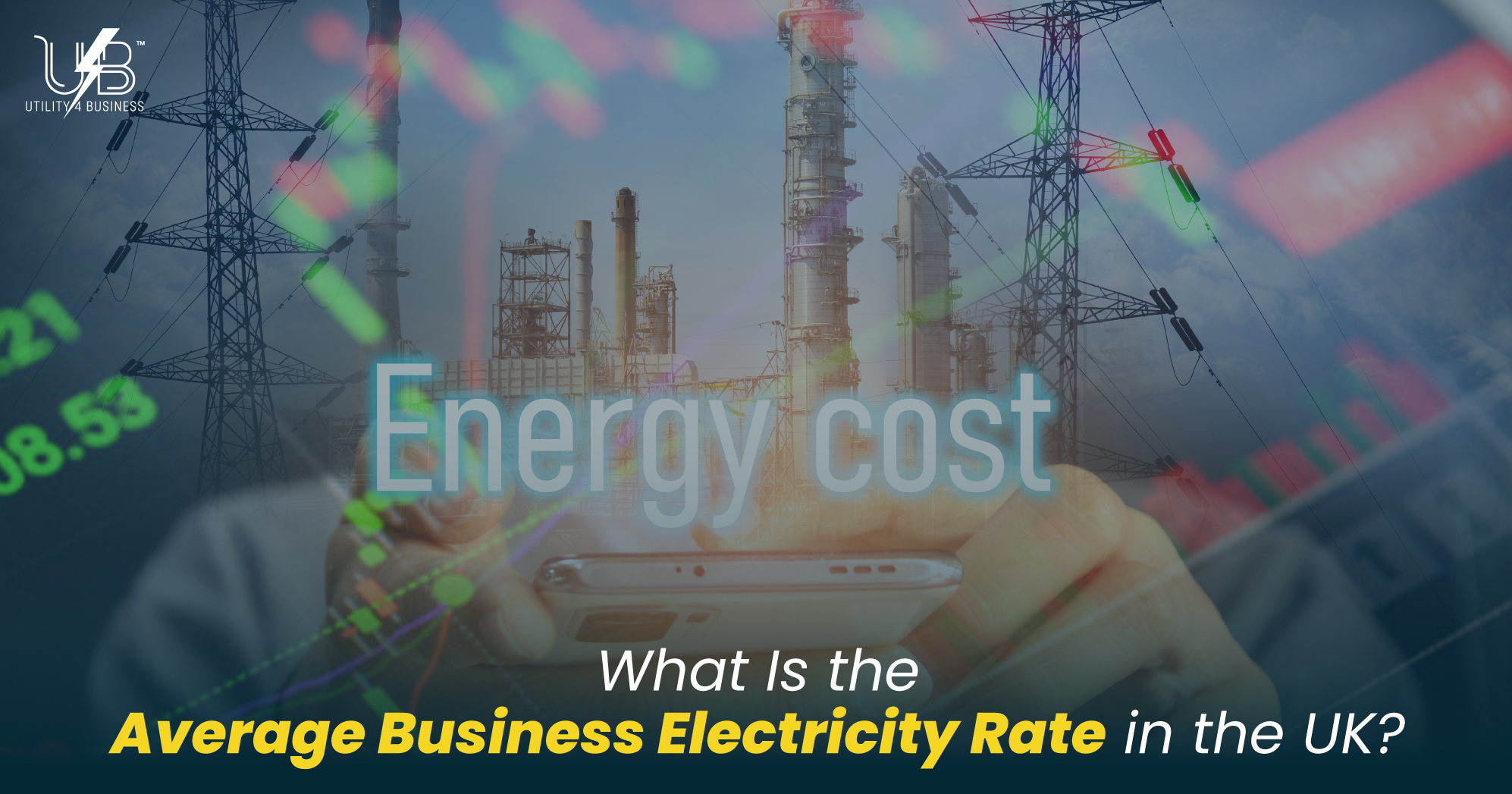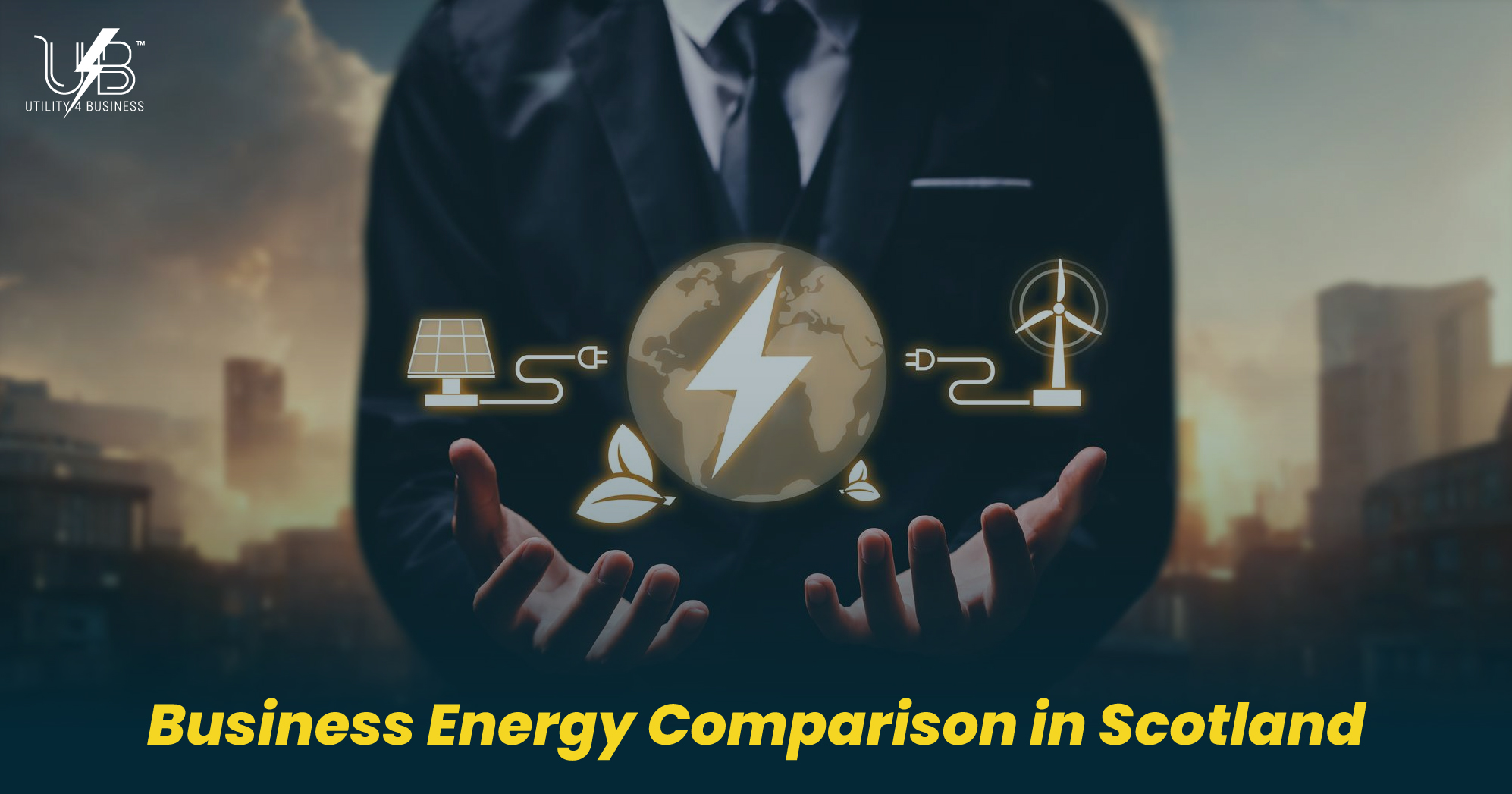What Is the Average Business Electricity Rate in the UK?
UK Business Energy Pricing Factors

Understanding the average business electricity rate in the UK helps you plan budgets, protect margins, and choose the right contract at renewal. Unlike domestic tariffs, non-domestic pricing reflects how a site uses power over the day, its metering, its region, and the structure of its contract. In this guide, Utility4Business explains business electricity rates in clear terms and answers the question many owners ask first: what is the average business electricity rate in the UK? We also show how to work out your own effective pence-per-kWh, why the “average” is only a starting point, and how a smart business electricity comparison can reduce total cost without fuss.
Why “Average” Is Only The Starting Point
When people search for an average rate, they want an anchor for planning. That anchor is useful, yet it can mislead if taken as a quote you should expect. Business electricity prices vary because of five realities:
- Consumption Size: Micro, small, and medium users face different pricing bands. Larger, steadier demand can unlock sharper unit rates but may introduce capacity-related charges.
- Load Shape: Two firms with the same annual kWh can pay different prices if one peaks at busy evening hours while the other runs off-peak. Half-hourly data makes this visible to suppliers and affects their costs.
- Contract Structure: Fixed, flexible, or hybrid deals spread risk differently. All-inclusive fixes can shield you from change, while pass-through structures expose some elements to published rates.
- Region and Networks: Network use-of-system charges vary by location. These are not purely wholesale energy costs, yet they influence the final figure you pay.
- Credit and Terms: Direct debit, prompt payment, and credit risk loading can nudge a price up or down at the margin.
A national “average” cannot capture these details. It serves as a benchmark, not a target. The right goal is an effective pence-per-kWh for your premises, computed from your actual use and all the charges on your bill.
Unit Rate Versus Standing Charge
Many businesses focus on the unit rate alone. That is natural, but it can hide the impact of fixed daily fees.
- Unit Rate: The price per kWh consumed.
- Standing Charge: A daily fixed amount per meter or site.
For low-usage sites, a small change in the standing charge can outweigh a modest change in the unit rate. For higher-usage sites, the unit rate dominates. The best procurement approach weighs both, then converts the contract into an effective p/kWh so you can judge options on a like-for-like basis during a business electricity price comparison exercise.
The Building Blocks Of A Business Electricity Price
To understand business electricity rates explained, it helps to break the bill into parts:
- Wholesale Energy: The underlying cost of electricity for the period your contract covers. This moves with markets and the forward curve.
- Network Charges: Costs for using the transmission and distribution networks. Recent reforms have shifted more costs into fixed daily bands based on meter type and size.
- Balancing Costs: System operators keep supply and demand matched in real time. The cost of balancing sits within non-commodity elements.
- Policy and Environmental Costs: Items such as environmental schemes and the Climate Change Levy (CCL) appear on bills according to your eligibility.
- Supplier Costs and Margin: Billing, metering, risk allowance, and operating costs.
A fixed contract blends these items into a single unit rate (plus a standing charge). A pass-through deal separates some elements and lets them float with published rates. Neither model is automatically “better”; the right choice depends on your appetite for certainty and transparency.
How To Calculate Your Own Effective p/kWh
You can turn any quote or bill into an effective p/kWh with a simple method. This helps you compare options fairly and supports a structured comparison of business electricity reviews.
- Collect Annual Consumption: Use 12 months of kWh data if possible. If you have half-hourly data, keep it; it is valuable for pricing and analysis.
- Add Up The Variable Cost: Multiply the quoted unit rate by your expected annual kWh.
- Include Standing Charges: Multiply the daily standing charge by 365 (or the contract length in days).
- Add Taxes and Levies: Include VAT and CCL if they apply to you.
- Divide by kWh: Divide the total annual cost by your annual kWh to get your effective p/kWh.
This single number lets you compare deals of different shapes and durations. It is the cleanest way to run a business energy comparison with confidence.
Fixed, Flexible, And Hybrid Contracts Explained
Fixed Contracts
A fixed contract sets the unit rate for the term, often 12, 24, or 36 months. Many non-commodity costs are bundled into that rate. The benefit is budgeting certainty. The trade-off is less exposure to potential falls in costs during the term. Fixed deals suit firms with tight margins or those that need clear, stable overheads.
Flexible (Pass-Through) Contracts
A flexible deal can pass some non-commodity elements directly to you at published rates, while the supplier sets a separate energy component. This increases transparency and can reduce risk premiums within the unit rate. It suits energy-aware businesses prepared to manage movement in certain components.
Hybrid Approaches
Some contracts fix specific elements and pass others through. For example, you might fix energy and distribution but pass on balancing costs or certain environmental elements. Hybrids can be a good compromise for firms that want some certainty without paying for a fully bundled profile.
Capacity, Metering, And The Impact On Costs
- Half-Hourly Metering: If your site settles half-hourly, suppliers can see your load profile in detail. Steady profiles often price better than spiky ones.
- Agreed Capacity: If you pay for capacity well above what you use, you might carry fixed costs that do not add operational value. A capacity review can trim your total.
- Power Factor Corrections: Poor power factor can increase network charges. Simple equipment changes sometimes improve this and reduce costs over time.
These technical details matter when you aim to beat the “average”. Optimising them before renewal can translate into better quotes during a business electricity comparison.
Timing Your Renewal Window
Markets move. If you start the process three to six months before the end date, you can:
- Track wholesale moves and pick a favourable dip.
- Compare multiple terms (12, 24, 36 months) side by side.
- Avoid default or out-of-contract rates that inflate cost.
- Prepare consumption data so suppliers can price you accurately.
Good timing does not guarantee the lowest possible rate, but it reduces the chance of paying a premium because of last-minute decisions.
Regional Differences And Network Effects
Where your meter sits in the country affects distribution charges. Two otherwise identical sites can pay different amounts because local networks recover their costs differently. For multi-site portfolios, aligning end dates and bundling meters can improve buying power and simplify management. Portfolio pricing can also smooth regional differences into a single blended result.
Common Reasons Quotes Appear “High”
If a quote seems high against your expectations or against what you think is the average, check the following:
- Contract Start Month: Winter starts can carry different forward costs than spring or early summer starts.
- Payment Method: Some suppliers discount direct debit and charge more for manual methods.
- Credit Review: A weaker credit score can add a risk premium.
- Load Shape: Evening-heavy or highly variable use may price higher than steady daytime profiles.
- Standing Charge Bands: Recent charging reforms increased the weight of fixed daily elements for some meters.
- Rollover Exposure: If you have drifted onto a default tariff, the rate will rarely be competitive.
Each factor can be addressed with data, negotiation, or simple operational changes. The aim is to bring your site’s profile in line with what the market prices most competitively, then lock it in through a well-timed business electricity price comparison.
Practical Steps To Lower Your Effective Rate
- Right-Size Capacity: Verify your agreed capacity against peak demand. If you have headroom you never use, you may reduce fixed charges.
- Trim Baseload: Audit always-on equipment. Even small nightly or weekend reductions compound into large annual savings.
- Shift Flexible Loads: Move discretionary processes outside evening peaks where practical.
- Upgrade Efficiency: LED lighting, variable-speed drives, and better controls often pay back quickly at modern prices.
- Use Half-Hourly Insights: If you have HH data, analyse it for spikes and idle loads. Vendors price steady demand more keenly.
- Consolidate Sites: Align renewal dates and buy as a portfolio if you run multiple locations.
- Review Contract Structure: If you prefer certainty, fix more elements. If you can manage movement and want transparency, pass some items through.
- Start Early: Give yourself room to compare, negotiate, and pick your moment.
Utility4Business supports each step, from data collection to presenting options in a single, clear comparison with an effective p/kWh for every scenario.
How Utility4Business Helps You Beat The Average
Our role is to translate complexity into a simple decision. We:
- Gather Your Data: Twelve months of kWh, meter information, and site details.
- Model Contract Shapes: Fixed, flexible, and hybrid options, compared side by side.
- Normalise Quotes: Convert every offer to an effective p/kWh, including standing charges, levies, and VAT where applicable.
- Optimise Timing: Track suitable windows ahead of renewal to avoid avoidable premiums.
- Spot Quick Wins: Capacity right-sizing, baseload reduction, and metering checks often improve pricing.
- Support Multi-Site Buying: Align terms and consolidate purchasing for better leverage.
The outcome is not a generic “average” but a contract shaped to your operations. That is where a guided business energy comparison pays off in real savings rather than theoretical gains.
Turning A Quote Into An Effective Rate
Imagine a small site uses 20,000 kWh a year.
- Quoted Unit Rate: Multiply 20,000 kWh by the p/kWh quoted to find the variable cost.
- Standing Charge: Multiply the daily standing charge by 365 to get the annual fixed cost.
- Taxes and Levies: Add VAT and CCL where they apply to your organisation.
- Effective p/kWh: Divide the grand total by 20,000 kWh.
Now repeat this for a 12-month fix, a 24-month fix, and a pass-through offer. Present the three totals and effective p/kWh side by side. The numbers will reveal which structure is better for your site, rather than leaving you to rely on a headline unit rate.
How To Use The “Average” In Budgeting
- Start With The Benchmark: Use the latest official non-domestic average to set a planning anchor for the next financial year.
- Apply Your Profile: Adjust for your expected standing charge, your usage, and your metering.
- Stress-Test: Model a plausible range above and below the anchor to prepare for market movement.
- Review Quarterly: As updated figures and quotes arrive, adjust your working number.
Budgeting this way keeps plans grounded while staying flexible enough to handle changes.
Where The Biggest Savings Usually Come From
In our experience at Utility4Business, businesses often save the most through:
- Avoiding Default Rates: Prevent rollovers with a timely renewal process.
- Fixing “Silent” Costs: Capacity that is set too high, or equipment running when it adds no value.
- Portfolio Buying: Aligning sites and consolidating power improves negotiating leverage.
- Right Contract Shape: Choosing fixed, flexible, or hybrid to match how you operate.
- Data-Led Quotes: Providing complete and accurate consumption data encourages sharper pricing.
None of these requires radical change. They come from detail, timing, and a transparent business electricity price comparison.
Bringing It All Together
The question of what the average business electricity rate in the UK is is sensible, but the answer you really need is the effective p/kWh for your meters, your hours, and your contract structure. National averages help with context; they do not buy power for your sites. The most reliable path to savings is a step-by-step method:
- Gather a clean year of consumption and meter data.
- Decide whether fixed, flexible, or hybrid best fits your risk profile.
- Normalise quotes into an effective p/kWh that includes all relevant charges.
- Time the renewal window and compare multiple terms.
- Fix silent charges, right-size capacity, and trim baseload.
- Lock in a contract that serves your operations, not a theoretical “average”.
Utility4Business can handle the details, present your options in plain English, and run a clear business electricity price comparison that gives you control. With the right preparation and a fair view of market choices, you can beat the average and keep energy where it belongs, supporting your growth rather than consuming your margin.
Find This Article Helpful? Share It Now!
At Utility4Business, we offer top-notch customer support and business utility solutions for businesses across the UK. Consider sharing this article and helping others discover how our expertise can add value to their business success.

Read Our Latest Posts
Explore our latest blog posts and learn how Utility4Business can support your business growth with tailored utility solutions and services. Stay ahead of the curve with the latest information from industry experts and take advantage of our user-friendly comparison services to find the best business deals.


Get Connected
At Utility4Business, our team of experts can help you figure out the highest-value business utility deals that will help your business grow over time.

